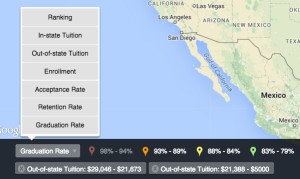Whenever the stock market fluctuates wildly in any direction you’ll read about people’s fortunes changing in a single day by what most of us will not make in a lifetime. Despite the wealth we can hardly understand, these billionaires do not each live on their own private island. In fact, most are in major cities around the world, often close to their business interests. The map below shows the hometowns of the world’s richest, according to the annual Forbes list.
View Cities with the Most Billionaires in a full screen map
This map may look a little different than the usual list you expect from Forbes. Where are Bill Gates, Carlos Slim, Warren Buffett, and others? They live in cities that are otherwise unpopular with their fellow billionaires. In fact, Forbes notes that these 20 cities are home to more than one-third of the world’s billionaires. But that leaves 1,181 of the richest that live elsewhere.
Gates lives in the Seattle, Washington, area, which does not have the 14 other billionaires, so his hometown misses this map, as does Slim’s Mexico City, and Buffett’s Lincoln, Nebraska. The cities that do make this map are internationally recognizable, from New York City (#1, 78 billionaires) to Jakarta (#20, 15 billionaires).
New York is to be expected, long the center of the world’s financial markets. Its counterpart across the Atlantic, London, is #4, with 46 billionaires. Between the two are the emerging powerhouses of Moscow (68) and Hong Kong (64). Rounding out the top five is Beijing (45), nipping at London’s heals.
The representatives from those cities may be faces you’re less familiar with. Certainly the Koch brothers of New York are perennial top 10s. But have you heard of Murat Ülker? The owner of a Turkish food conglomerate, Ülker has a net worth of $4.4 billion and a Wikipedia page with a biography of fewer than 100 words.
Similarly, Facebook co-founder Dustin Moskovitz does not have the household name of Mark Zuckerberg, but Moskovitz is the richest person in San Francisco. Here is the full list of the top 20 cities that the rich call home, along with the most affluent resident.
| Rank | City | Billionaires | Richest | Net worth | Source |
| 1 | New York, New York | 78 | David Koch | $42.9 B | diversified |
| 2 | Moscow, Russia | 68 | Vladimir Potanin | $15.4 B | metals |
| 3 | Hong Kong | 64 | Li Ka-shing | $33.3 B | diversified |
| 4 | London, United Kingdom | 46 | Len Blavatnik | $20.2 B | diversified |
| 5 | Beijing, China | 45 | Wang Jianlin | $24.2 B | real estate |
| 6 | Mumbai, India | 33 | Mukesh Ambani | $21 B | petrochemicals, oil & gas |
| 7 | Seoul, South Korea | 29 | Lee Kun-Hee | $11.3 B | electronics/insurance |
| 8 | Istanbul, Turkey | 28 | Murat Ulker | $4.4 B | food manufacturing |
| 9 | Paris, France | 27 | Liliane Bettencourt & family | $40.1 B | L’Oreal |
| 10 | San Francisco, California | 26 | Dustin Moskovitz | $7.9 B | |
| 11 | Sao Paul, Brazil | 25 | Jorge Paulo Lemann | $25 B | beer |
| 11 | Shenzhen, China | 25 | Ma Huateng | $16.1 B | internet media |
| 13 | Taipei, Taiwan | 24 | Terry Gou | $6.1 B | electronics |
| 14 | Los Angeles, California | 22 | Patrick Soon-Shiong | $12.2 B | pharmaceuticals |
| 14 | Singapore | 22 | Robert & Philip Ng | $9.6 B | real estate |
| 16 | Shanghai, China | 19 | Tsai Eng-Meng | $8.9 B | food, beverages |
| 17 | Delhi, India | 17 | Shiv Nadar | $14.8 B | information technology |
| 18 | Dallas, Texas | 16 | Andrew Beal | $11.7 B | banks, real estate |
| 18 | Tokyo, Japan | 16 | Tadashi Yanai & family | $20.2 B | retail |
| 20 | Jakarta, Indonesia | 15 | Chairul Tanjung | $4.3 B | diversified |
If you’d like to see the ways to visualize the data above on BatchGeo, you can create a map like the one above by simply copying the figures above into our map making tool. Or keep exploring money makers with this map of US incomes, though you’ll find those numbers a bit smaller than the billionaires discussed above.


 Perhaps exclusivity is not your thing. Click the group selector to clear your selections, then choose the Out-of-state tuition option. This provides the best apples-to-apples comparison for the cost of college, because in-state tuition typically has strict resident requirements. Choose the lowest three tuition ranges to see all the universities with less than about $30,000 annual cost.
Perhaps exclusivity is not your thing. Click the group selector to clear your selections, then choose the Out-of-state tuition option. This provides the best apples-to-apples comparison for the cost of college, because in-state tuition typically has strict resident requirements. Choose the lowest three tuition ranges to see all the universities with less than about $30,000 annual cost.